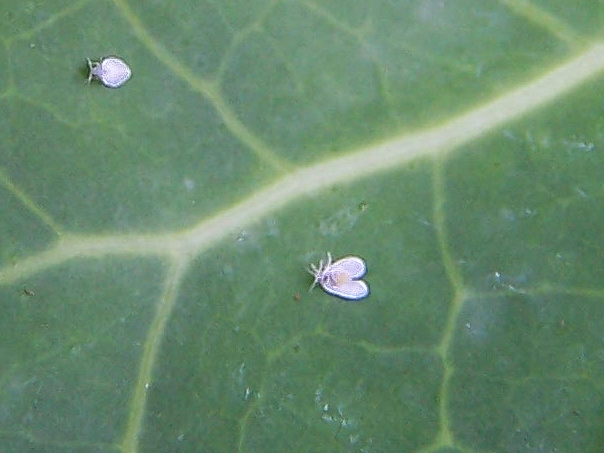

Home
About Us
Allotments
Garden Equipment
Seed Suppliers
Manure Problems
Children's Pages
GLA Blog
Weather Blog
School Veg Patch
Useful Links
Whitefly
It just doesn't seem to be possible at the moment to do anything on the plot without whitefly getting in on the act.
I have even had them decide to take a bath in my coffee and when weeding it is advisable to keep your mouth firmly shut only breathing in when absolutely necessary.
As soon as any type of plant is gently touched clouds of these tiny moth like insects rise into the air.
I thought all whitefly were the same but apparently 56 different species of whitefly have been found in Europe and 1400 species worldwide. The whiteflies that feed on your cabbages are a different species from the ones that feed on greenhouse plants. The cabbage whitefly has grey spots on the centre of each wing but is so tiny that you are unlikely to spot the difference.

Whiteflies mount a two pronged attack on plants. They feed by sucking sap from the plant. Both adults and larvae prefer to hide on the undersides of leaves. This gives them protection from predators and bad weather. The larvae are only mobile when they first hatch and at this stage are called crawlers. They crawl to an area of leaf where they attach themselves and remain immobile feeding until they develop into adults. The adults will then only live for a few days.
Although whiteflies are tiny the sheer numbers of them cause a problem. Not only do they suck sap and weaken plants but also like aphids they excrete a sugary substance on which sooty mould develops. The sooty mould doesn’t directly harm the plant but it prevents adequate sunlight reaching the leaf surface which the plant needs in order to produce its food. It also renders food plants unappetising.
Whitefly activity can also introduce plant viruses and diseases.
Control of whiteflies is very difficult. Not only are they covered with a waxy substance that makes them immune to any water based sprays but they reproduce extremely quickly. From egg to adult takes about four weeks and each female lays 200 eggs. What’s more a female doesn’t need to mate in order to reproduce, she is born capable of laying eggs from which only female whitefly will emerge. Mated whitefly females lay eggs capable of developing into either males or females. The huge numbers of them will ensure that whatever control method you attempt many will survive.
It seems that the only way to keep them at bay is to cover everything with fleece. We have resorted to growing brassicas under enviromesh but to cover everything is hardly a practical solution.
I have read many other suggestions means of controlling whitefly such as:
- Once adult flies are noticed using a natural soap product to control them. Apparently a weak solution of one teaspoon of Stergene to one pint of water is effective on ornamental plants! Spray should be applied to the underside of leaves.
- In greenhouses reducing the number of whitefly by using an introduced parasite; however this will only control the numbers and will not remove them entirely.
- Hanging up sticky yellow traps which attract whitefly but again these will only reduce the numbers and other innocent insects are also likely to fall victim.
- Attracting natural predators such as birds, lacewings and ladybirds can help keep numbers down.
- Some also maintain that whiteflies are repelled by marigolds, nasturtiums, basil and mint.
- Using a hand held vacuum cleaner can be used to suck up the flies being careful not to ruin your plants in the process. Ypu should tap the plant and aim the suction at the cloud of flies that rise from the plant. One problem is that this is unlikely to kill the whitefly and so they will be released when the vacuum is emptied. One suggestion that I have read is to pop the vacuum in a plastic bag in the freezer to kill the flies before emptying which I wouldn't fancy doing!
In mild winters, whiteflies overwinter on weed plants and so weeding is important in winter too as is the removal of any dead plant material.
Commercial growers use pesticides to control the number of whitefly, however the recommended products contain a compound – neonicotinoid – which is suspected of adversely affecting bees and being one of the factors behind the serious reduction of our bee population. Whiteflies also quickly build up immunity to pesticides.
Anyone who comes up with a successful solution could very well become a millionaire.
Our Plot at Green Lane Allotments Blog | A Gardener's Weather Diary | School Vegetable Patch Website
© Our Plot on Green Lane Allotments - Please email me if you wish to use any of this site's content